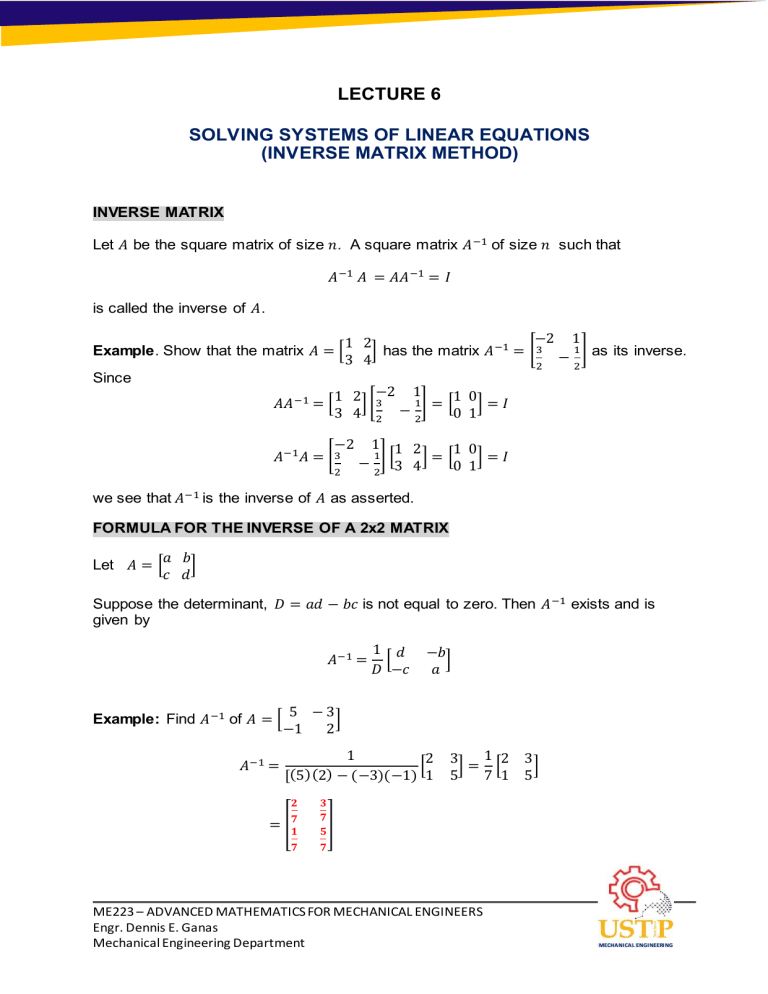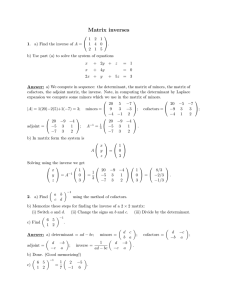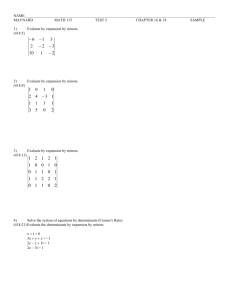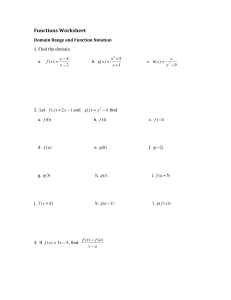
1 LECTURE 6 SOLVING SYSTEMS OF LINEAR EQUATIONS (INVERSE MATRIX METHOD) INVERSE MATRIX Let 𝐴 be the square matrix of size 𝑛. A square matrix 𝐴 −1 of size 𝑛 such that 𝐴 −1 𝐴 = 𝐴𝐴 −1 = 𝐼 is called the inverse of 𝐴. Example. Show that the matrix 𝐴 = [ Since 𝐴𝐴 −1 = [ −2 1 1 2 ] has the matrix 𝐴 −1 = [3 − 1 ] as its inverse. 3 4 2 2 1 1 2 [−2 1 0 ] 3 − 1] = [ ]=𝐼 3 4 2 0 1 2 −2 1 1 2 1 0 𝐴 −1 𝐴 = [3 − 1] [ ]= [ ]=𝐼 3 4 0 1 2 2 we see that 𝐴 −1 is the inverse of 𝐴 as asserted. FORMULA FOR THE INVERSE OF A 2x2 MATRIX 𝑎 𝑏 Let 𝐴 = [ ] 𝑐 𝑑 Suppose the determinant, 𝐷 = 𝑎𝑑 − 𝑏𝑐 is not equal to zero. Then 𝐴 −1 exists and is given by 𝐴 −1 = Example: Find 𝐴 −1 of 𝐴 = [ 𝐴 −1 = 1 𝑑 [ 𝐷 −𝑐 −𝑏 ] 𝑎 5 −3 ] −1 2 1 2 [ ( )( ) [ 5 2 − (−3)(−1) 1 𝟐 = [𝟕𝟏 𝟕 1 2 3 3 ]= [ ] 5 7 1 5 𝟑 𝟕 ] 𝟓 𝟕 ME223 – ADVANCED MATHEMATICS FOR MECHANICAL ENGINEERS Engr. Dennis E. Ganas Mechanical Engineering Department MECHANICAL ENGINEERING 2 STEPS IN FINDING THE INVERSE OF A 3x3 MATRIX USING MINORS AND COFACTORS: Steps in solving for the Inverse of a Matrix: 1: Calculate the Matrix of Minors, 2: Turn the Matrix of Minors into the Matrix of Cofactors, 3: Adjugate or Adjoint, and 4: Multiply that by 1/Determinant. Example: Find the inverse matrix of 𝐴. 3 𝐴 = [2 0 0 2 0 − 2] 1 1 Step 1: Matrix of Minors The first step is to create a "Matrix of Minors". This step has the most calculations. For each element of the matrix: ignore the values on the current row and column calculate the determinant of the remaining values Put those determinants into a matrix (the "Matrix of Minors") Here are the first two, and last two, calculations of the "Matrix of Minors" (Ignore the values in the current row and columns, and calculate the determinant using the remaining values): 𝟑 [2 0 0 2 𝟎 − 𝟐] (0)(1) − ( −2)(1) = 2 𝟏 𝟏 3 [𝟐 𝟎 𝟎 2 0 − 𝟐] (2)(1) − ( −2)(0) = 2 1 𝟏 𝟑 [𝟐 0 0 𝟐 0 − 𝟐] (3)(−2) − (2)(2) = −10 𝟏 1 𝟑 [𝟐 0 𝟎 2 𝟎 − 2] (3)(0) − (0)(2) = 0 1 𝟏 ME223 – ADVANCED MATHEMATICS FOR MECHANICAL ENGINEERS Engr. Dennis E. Ganas Mechanical Engineering Department MECHANICAL ENGINEERING 3 And here is the calculation for the whole matrix: (0)(1) − (−2)(1) ( [ 0)(1) − (2)(1) (0)(−2) − (2)(0) (2)(1) − (−2)(0) (3)(1) − (2)(0) (3)(−2) − (2)(2) (2)(1) − (0)(0) 𝟐 𝟐 𝟐 (3)(1) − (0)(0) ] = [ −𝟐 𝟑 𝟑] (3)(0) − (0)(2) 𝟎 − 𝟏𝟎 𝟎 Step 2: Matrix of Cofactors Change the sign of alternate cells, like this: + [− + 2 2 2 [ −2 3 3] 0 − 10 0 − + − + −] + 𝟐 [ 𝟐 𝟎 − 𝟐 𝟑 𝟏𝟎 𝟐 − 𝟑] 𝟎 Step 3: Adjugate (or Adjoint) Transpose all elements of the previous matrix (Matrix of Cofactors) by swapping their positions over the diagonal (the diagonal stays the same): 2 [ 2 0 Step 4: Multiply by − 2 3 10 2 − 3] 0 𝟐 [−𝟐 𝟐 𝟐 𝟑 −𝟑 𝟎 𝟏𝟎] 𝟎 𝟏 𝑫𝒆𝒕𝒆𝒓𝒎𝒊𝒏𝒂𝒏𝒕 Now find the determinant (𝐷) of the original matrix. This isn't too hard, because we already calculated the determinants of the smaller parts when we did "Matrix of Minors". 𝟑 0 2 3 𝐷 = [ 2 𝟎 − 𝟐 ] − [𝟐 0 𝟏 𝟏 𝟎 𝟎 2 3 0 − 𝟐] + [𝟐 1 𝟏 𝟎 0 𝟐 𝟎 − 2] 𝟏 1 𝐷 = 3[(0)(1) − (−2)(1)] − 0[(2)(1) − (−2)(0)] + 2[(2)(1) − (0)(0) ] = 3[2] − 0 + 2[2] = 𝟏𝟎 In practice we can just multiply each of the top row elements by the cofactor for the same location: Elements of top row: 3, 0, 2 Cofactors for top row: 2, −2, 2 𝑫 = 𝟑 × 𝟐 + 𝟎 × (−𝟐) + 𝟐 × 𝟐 = 𝟏𝟎 ME223 – ADVANCED MATHEMATICS FOR MECHANICAL ENGINEERS Engr. Dennis E. Ganas Mechanical Engineering Department MECHANICAL ENGINEERING 4 Finally, multiply the Adjugate by 𝐴 −1 = 𝟏 𝑫𝒆𝒕𝒆𝒓𝒎𝒊𝒏𝒂𝒏𝒕 2 1 [−2 10 2 2 3 −3 . 0 𝟎. 𝟐 𝟎. 𝟐 10] = [−𝟎. 𝟐 𝟎. 𝟑 0 𝟎. 𝟐 − 𝟎. 𝟑 𝟎 𝟏] 𝟎 SOLVING LINEAR SYSTEMS OF EQUATIONS USING INVERSE MATRIX METHOD 1. Solve for 𝑥, 𝑦 and 𝑧. 2𝑥 − 2𝑦 + 4𝑧 = 10 3𝑥 − 6𝑦 + 6𝑧 = 18 −2𝑥 + 5𝑦 − 3𝑧 = −11 Step 1: We may write the equations in the form 𝐴𝑋 = 𝐵. 2 −2 𝐴 = [3 −6 −2 5 4 6] −3 𝑥 𝑋 = [𝑦 ] 𝑧 10 𝐵 = [ 18 ] −11 Step 2: Solve for the Inverse of 𝐴 using minors and cofactors. I. Matrix of Minors 2 −2 [3 −6 −2 5 4 6] −3 −12 [ −14 12 3 3 2 6] 0 −6 II. Matrix of Cofactors −12 [ −14 12 3 3 2 6] 0 −6 −12 − 3 3 [ 14 2 −6 ] 12 0 −6 III. Adjugate −12 − 3 3 [ 14 2 −6 ] 12 0 −6 −12 14 [ −3 2 3 −6 12 0 ] −6 IV. Divide by determinant, 𝐷 𝑫 = −𝟔 𝐴 −1 = 1 −12 14 [ −3 2 −6 3 −6 12 14 − 6 6 12 3 2 0 ]= − 6 6 −6 3 6 [ 6 6 − ME223 – ADVANCED MATHEMATICS FOR MECHANICAL ENGINEERS Engr. Dennis E. Ganas Mechanical Engineering Department 12 6 0 6 6 ] 𝟐 = 𝟏 𝟐 𝟏 − [ 𝟐 𝟕 𝟑 𝟏 − 𝟑 − 𝟏 −𝟐 𝟎 𝟏] MECHANICAL ENGINEERING 5 V. Solve for x, y and z. Recall that 𝐴𝑋 = 𝐵 2 −2 𝐴 = [3 −6 −2 5 4 6] −3 𝑥 [ 𝑋 = 𝑦] 𝑧 10 𝐵 = [ 18 ] −11 So that, 𝐴 −1(𝐴𝑋) = 𝐴 −1 𝐵 𝑥 [𝑦 ] = 𝑧 2 − 1 2 − 1 [ −2 7 3 1 3 1 𝑋 = 𝐴 −1 𝐵 −2 0 1] 10 [ 18 ] −11 7 (2)(10) − ( ) (18) + (−2)(−11)) 3 1 1 = ((2 ) (10) − ( 3) (18) + (0)(−11)) 1 (− ( ) (10) + (1)(18) − (1)(11)) 2 [ ] 𝟎 = [−𝟏] 𝟐 therefore 𝒙 = 𝟎, 𝒚 = −𝟏 and 𝒛 = 𝟐. PROBLEM SET 2: Solve the following systems of linear equations using Inverse Matrix Method. 1. 3𝑥 − 𝑦 + 𝑧 = −1 2𝑥 + 3𝑦 + 𝑧 = 4 5𝑥 + 4𝑦 + 2𝑧 = 5 2. 2𝑥 + 𝑦 + 𝑧 = −2 2𝑥 − 𝑦 + 3𝑧 = 6 3𝑥 − 5𝑦 + 4𝑧 = 7 DUE: MARCH 20, 2021 5pm. ME223 – ADVANCED MATHEMATICS FOR MECHANICAL ENGINEERS Engr. Dennis E. Ganas Mechanical Engineering Department MECHANICAL ENGINEERING






